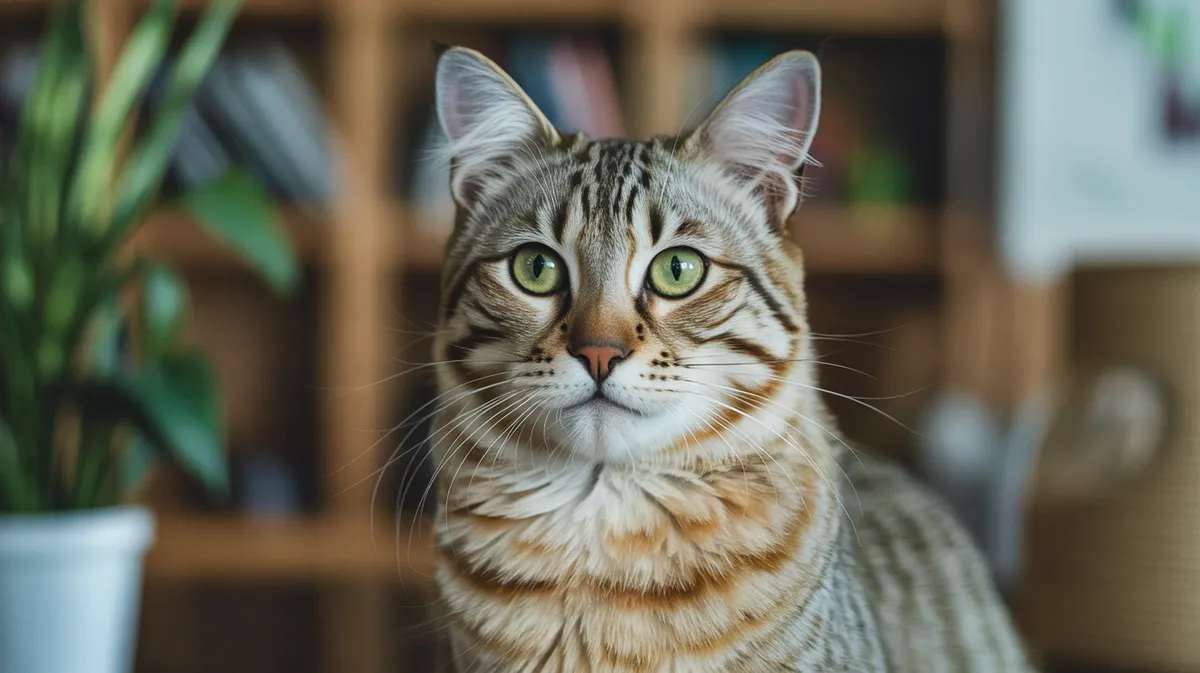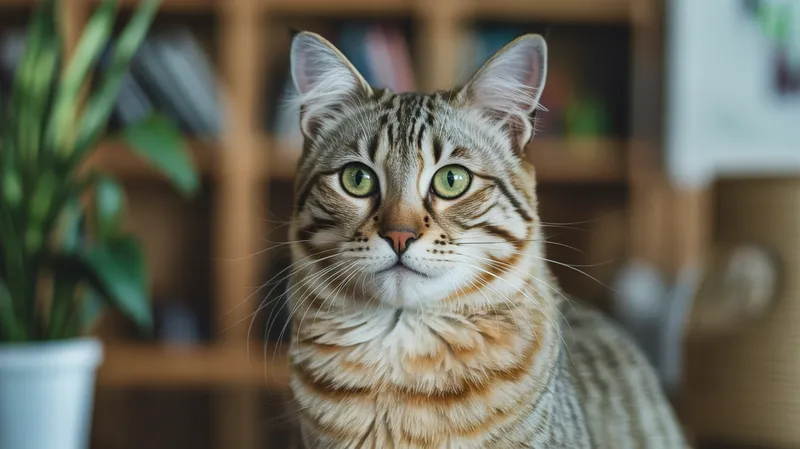
Mandalay Cat
Felis catus

Meet the Mandalay Cat
The Mandalay is a rare and elegant domestic cat breed originating from New Zealand, recognized for its striking golden-brown coat and expressive yellow eyes. Developed in the late 20th century by selectively breeding Burmese cats with sable coats, the Mandalay has a short, fine, and glossy fur that shimmers in the light. They are medium-sized, muscular, and known for their affectionate, playful, and highly social temperament. Mandalay cats are intelligent and active, often seeking out human companionship and interactive play. Their unique coloration and outgoing personality make them a favorite among enthusiasts, though they remain quite rare globally.
Classification
Mammal
Habitat
Domestic, indoor environments
Diet
Carnivore
Lifespan
12-16 years
Conservation
Not Evaluated
Weight
3-5 kg
📖Fascinating Facts
Unique Sable Coat
The Mandalay's coat is exclusively a rich, warm sable brown, with a gloss that gives it a luxurious look.
Highly Intelligent
Mandalay cats are quick learners and can be taught tricks or to fetch, similar to dogs.
Rare Breed
This breed is primarily found in New Zealand and Australia, with very limited numbers worldwide.
📋Detailed Description
The Mandalay cat is a medium-sized, muscular feline, typically weighing between 3.5 and 6 kilograms (7.7–13.2 lbs), with males generally larger than females. Its most distinguishing feature is the rich, golden-brown (sable) coat, which is short, fine, and close-lying, giving it a glossy, almost metallic sheen. The head is gently rounded with prominent cheekbones, a short, broad muzzle, and large, expressive yellow to amber eyes set wide apart, conveying an alert and inquisitive expression. The ears are medium-sized, slightly rounded at the tips, and set well apart, enhancing the breed’s attentive appearance. Mandalay cats possess a compact yet athletic build, with a strong chest, straight back, and well-developed limbs ending in small, oval paws. Their tails are medium in length, tapering gracefully to a rounded tip. Behaviorally, Mandalay cats are highly social and thrive on interaction with humans and other pets, often forming strong bonds with their families. They exhibit high intelligence and curiosity, enjoying puzzle toys and interactive play. Their vocalizations are moderate, typically consisting of soft, melodic chirps and trills rather than loud meows. The breed is known for its adaptability to indoor environments, making it well-suited for apartment living, though it requires ample mental and physical stimulation.
💡 Did you know?
Despite their similarity to the Burmese breed, Mandalay cats are genetically distinct and are only recognized as a separate breed in a few countries.
🔬Research & Sources
🎭Behavior & Social Structure
Mandalay cats are notably active and playful, maintaining kitten-like energy well into adulthood. They are known for their affectionate nature, often following their owners from room to room and seeking physical contact, such as sitting on laps or curling up beside people. Socially, they are tolerant of other cats and dogs, and their gentle disposition makes them suitable for families with children. Mandalays are intelligent problem-solvers and can be trained to perform tricks or walk on a leash. Their predatory instincts are expressed through vigorous play, including stalking, pouncing, and batting at toys, though as indoor cats, actual hunting is rare. They establish daily routines, often greeting owners at the door and participating in household activities. Mandalays are sensitive to changes in their environment and may become stressed by prolonged solitude or disruption, underscoring their need for companionship and environmental enrichment.
👶Reproduction & Life Cycle
Mandalay cats reach sexual maturity between 5 and 9 months of age, with females typically entering their first estrus (heat) cycle around this time. Breeding is usually managed by registered breeders to maintain genetic health and breed standards. The gestation period averages 63–65 days. Litters typically consist of 3 to 6 kittens, which are born blind and helpless. Queens (female cats) exhibit strong maternal instincts, providing warmth, grooming, and protection to their young. Kittens begin to open their eyes at 7–10 days and are weaned by 8–10 weeks. Socialization during the early weeks is crucial for developing the Mandalay’s characteristic friendly temperament. There is no strict breeding season for domestic cats kept indoors, but in natural conditions, breeding may peak in spring and summer.
🛡️Adaptations & Survival
The Mandalay’s short, fine coat is an adaptation to indoor living, requiring minimal grooming and reducing the risk of matting. Their muscular build and agile limbs enable swift, graceful movement, supporting their playful and athletic behavior. The breed’s expressive eyes and social vocalizations facilitate communication with humans, an evolutionary trait favored in companion animals. High intelligence and curiosity are behavioral adaptations that allow Mandalays to thrive in complex domestic environments, quickly learning routines and responding to training. Their strong social bonds and tolerance for other pets are likely the result of selective breeding for companionable traits.
📚Research Sources
🎨Cultural Significance
The Mandalay cat holds a special place in New Zealand’s feline breeding history, representing a successful effort to develop a unique breed with both aesthetic appeal and a gentle temperament. While not associated with ancient mythology or traditional uses, the Mandalay is celebrated in cat fancier circles for its beauty and affectionate nature. The breed’s name references the city of Mandalay in Myanmar (Burma), reflecting its Burmese ancestry and lending an exotic allure. Mandalay cats are occasionally featured in cat shows and breed exhibitions, where their striking appearance and engaging personalities attract attention.
🔬Recent Research & Discoveries
Recent research on the Mandalay cat has focused on genetic diversity and health, with studies comparing its genome to that of Burmese and other related breeds. Veterinary investigations have found the Mandalay to be generally robust, though breeders monitor for hereditary conditions such as craniofacial defects and hypokalemia, which are known in Burmese lines. Ongoing research by breed clubs and geneticists aims to expand the breed’s gene pool and document its unique traits. Behavioral studies highlight the Mandalay’s high sociability and intelligence, supporting anecdotal reports from owners and breeders. The breed’s rarity limits large-scale scientific studies, but collaborative efforts among breeders in New Zealand and Australia continue to document health and temperament.
🎥Wildlife Videos

THE GHOST OF THE FOREST | Clouded Leopard
The mian role of zoos is species conservation. The decrease in population of the clouded leopards promted our decision to take ...
ZOO Wrocław

Ambient The Road To Mandalay
ambient-the-road-to-mandalay-5782, Daisy, White Flower, Bloom, Dandelion, Spore, Flower, Dandelion, Spring, Wind, Dark, ...
waveplus

Siegfried & Roy's Secret Garden and Dolphin Habitat - The Mirage Hotel and Casino - Las Vegas Nevada
White tigers, lions, leopards, panthers and dolphins in Siegfried & Roy's Secret Garden and Dolphin Habitat at the Mirage Hotel ...
Allan Nightingale

Siegfried And Roy's Secret Garden and Dolphin Habitat
newdaycleveland

Siegfried & Roy's Secret Garden: Dolphin & Tiger Habitat At The Mirage in Las Vegas FULL EXPERIENCE!
I went to Siegfried & Roy's Secret Garden and Dolphin Habitat at The Mirage Hotel and Casino in Las Vegas Nevada. It's a small ...
AustyVlog (Austy)
🌍Habitat Information
The Mandalay Cat typically inhabits Domestic, indoor environments environments. Mandalay Cats have adapted to their environments with specialized features and behaviors.
Primary Habitat:
Domestic, indoor environments
More detailed habitat information will be available soon.
🛡️Conservation Status
The Mandalay Cat is currently classified as Not Evaluated. Conservation efforts are crucial for preserving this species for future generations.
Common Threats:
- 🏠Habitat loss and fragmentation
- 🌡️Climate change impacts
- 🎯Hunting and poaching
- 🏭Human-wildlife conflict
⚠️Threats & Conservation Challenges
As a rare breed, the Mandalay faces challenges related to a limited gene pool, which can increase the risk of inherited health issues if not managed through responsible breeding practices. There are no significant natural threats, as Mandalays are almost exclusively kept as indoor pets. However, the breed’s rarity and limited global distribution make it vulnerable to population bottlenecks and loss of genetic diversity. Human impact is primarily positive, as breeders and enthusiasts work to promote breed health and awareness. The Mandalay is not currently evaluated by the IUCN, and there are no known wild populations. Ongoing challenges include maintaining breed standards and preventing inbreeding.
🔬Scientific Classification
Scientific Name
Felis catus
Classification Hierarchy
🔍 About Taxonomic Classification
Taxonomic classification is a hierarchical system used by scientists to classify and organize living organisms based on shared characteristics and evolutionary relationships.
The system moves from broad categories (Kingdom) to increasingly specific ones, with each animal's scientific name typically consisting of its Genus and species.
📝Community Notes
Share your observations and insights about the Mandalay Cat with our community of wildlife enthusiasts.
Join Our Community
Sign in to share your observations and connect with fellow wildlife enthusiasts.
Sign In to ContributeNo community notes yet
Be the first to share your observations about the Mandalay Cat!
Explore Mandalay Cat
Select a tab above to learn more about this amazing animal.
📸Photo Gallery
No photos available for this animal yet.
🌟Discover More Wildlife
Continue your journey of discovery with more fascinating animals from our database
